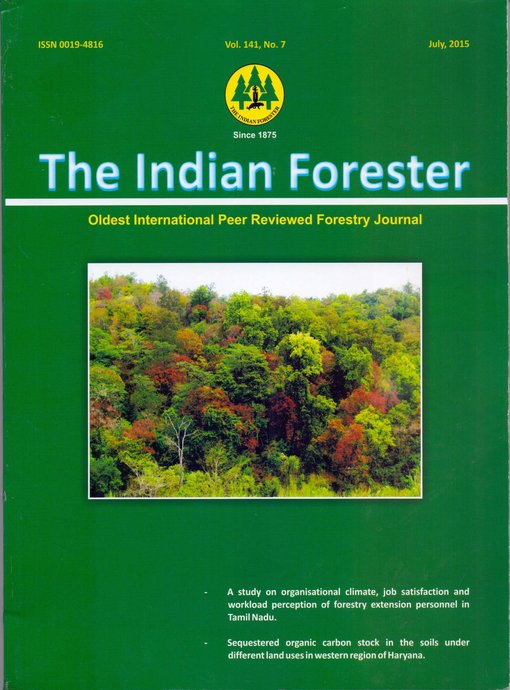Harnessing Major Nectar Bearing Forest Plants in some Potential Regions of Ethiopia-an overview of Observations for Profitable Beekeeping
DOI:
https://doi.org/10.36808/if/2015/v141i7/73933Keywords:
Aromatic Honey, Diversified Trees, Household Livelihood, Nectar, Pollen.Abstract
In Ethiopia, forests play an important role in enhancing household livelihood of residing rural communities besides maintaining ecological balance. More than 50% of the bee colonies are active in the forest areas where different trees, shrubs and herbs are to be found growing, having variable flowering period thereby providing a source for five races of honeybees for collecting nectar and pollens. It is because of the presence of diversified trees that forests remain a source of assured honey when compared to crops in cultivated areas. Out of total 40 major trees present in the forest, seven of them like Erica arboreal, Eucalyptus spp, Euphorbis candelabrum, Diospyros mespeliformis, Piliostigma thonningii, Azadirachta indica and Dracaena afromontana are reported to be exclusively source of nectar. Trees like Schinus molle hold promise as a major source of pollen. Out of a total 30 herbs and shrubs, herbs plants like Bidens spp., Guizotia scabra, Hypoestes forskalii and Agave sisalana are assured source of nectar while four shrubs i.e. Hypericum revolutum, Plantago lanceola, Solanum nigrum and Rumex nervosus are abundant source of pollen to meet the protein requirements of honey bees.References
Anon. (2014). Ethiopia Agribusiness Investment Forum. Addis Ababa, Ethiopia. Fortune, 14:88
Anon. (2010). Ethiopian Forest Resources current status and future management options in view of a access to carbon finances prepared for the Ethiopian climate research and networking and the United Nations Development Programme (UNDP), Addis Ababa, 2010.
Amsalu A., Bezabeh Nuru A., Sarah E. Radloff H. Randaell HEPBURN. (2003). Multivariate morphometric analysis of honeybees (Apis mellifera) in the Ethiopian Region: Apidologie, 35(2004) 71-81.
Azage T., Berhanu G., Hocksra D. (2006). Institutional arrangements and challenges in market oriented livestock in Ethiopia. In: Proceedings of the Annual Conference of the Ethiopian Society of animal production (ESAP). Addis Ababa, Ethiopia, 5-7 September 2006.
Bayissa D.L. (2006). The Roles of Apiculture in Vegetation Characterization and Household Livelihoods in Walmara District, Central Ethiopia. M.Sc. Thesis. Wondo Genet College of Forestry, Hawasa University, Hawassa, Ethiopia
Belissa M. Tola A. and Kebede G. (2004). Farm animal biodiversity in Ethiopia. Status and prospects.. Proceedings of the 11th annual Conference of the Ethiopian society of animal production (ESAP). (Yimegnuhal A. and Degefa T. eds) Addis Ababa, Ethiopia, August 28-30, 2003.
Chandler M.T. (1976). The African Honeybees, Apis mellifera adansonii. In: Proceedings of the first International Conference on Apiculture in Tropical Climates. London. UK. 1976.
CSA (Central Statistical Agency) (2007). Agricultural Sample survey of 2007. Volume II report on: Livestock and Livestock Characteristics. Central Statistical Agency, Addis Ababa, Ethiopia
Debissa L. (2007) Beekeeping: A livelihood strategy in Pastoral and Agro-Pastoral Dryland areas of Southern Oromia (Liban district and somali regional states (Filtu and Dollo Ado districts) Ethiopia.
Deffar G. (1998). Non wood Forest Production in Ethiopia. Addis Ababa, Ethiopia.
EEPD (2006). Ethiopian Export Promotion Department: Exports of honey and beeswax. Draft report. EEPD, Ministry of Trade and Industry, Addis Ababa, Ethiopia.
EFAP (Ethiopian Forestry Action Program). (1994). The Challenge for development. Vol II Summary. Final Report. Ministry of Natural Resources Development and Environmental protection. Addis Ababa Ethiopia.
Ejigu K., Gebey T. and Presaton T.R. (2009). Constraints and Prospects for apiculture research and development in Amhare region, Ethiopia.
Fichtl R. and Admassu A. (1994). Honeybee flora of Ethiopia. Margraf Verlage, Germany.
Gebeyehu Tesfaye Kebede, Sebsibe Zuber, Tekalign Gutu, Gurmessa Umeta, Tesfaye Lemma and Hundessa F. (2010). Participatory rural appraisal investigation on beekeeping in Arsi Negeklle and Shashe mene districts of West Arsi zone of Oromia , Ethiopia , Livestock Research for rural Development, 22(7).
Hall P. and Bawa K.S. (1993). Methods to assess the impact of extraction of non-timber tropical forest products on plant populations. Economic Botany, 47: 234-237.
HBRC (Holeta Bee Research Center) (1997). Beekeeping Training Manual (unpublished) HBRC Holeta, Ethiopia 207 pp.
Kandari L.S. and Omprakash M.D. (2009). Enhancing livelihood through NTFP collection: A case study of Keonjhar district, Orissa, India. Annals of Forestry, 17: 251-257.
Lemessa D. (2007). Beekeeping: A Livelihood Strategy in Pastoral and Agro-pastoral Dry Land Areas of Southern Oromia (Libian District) and Somali Regional States, Filtu and Dolle.
Mahapatra A.K., and Tiwari D.D. (2005). Importance of non-timber forest products in the economic valuation of dry deciduous forests of India. Forest Policy and Economics,7:455-467.
Maikhuri R.K., Rao K.S., Chauhan K., Kandari L.S., Prasad P. and Rajsekaran C. (2002). Development of marketing of medicinal plants and other forest products-can it is a apathway for effecvtive management and conservation. Indian Forester, 129:169-178.
Downloads
Downloads
Published
How to Cite
Issue
Section
License
Unless otherwise stated, copyright or similar rights in all materials presented on the site, including graphical images, are owned by Indian Forester.





